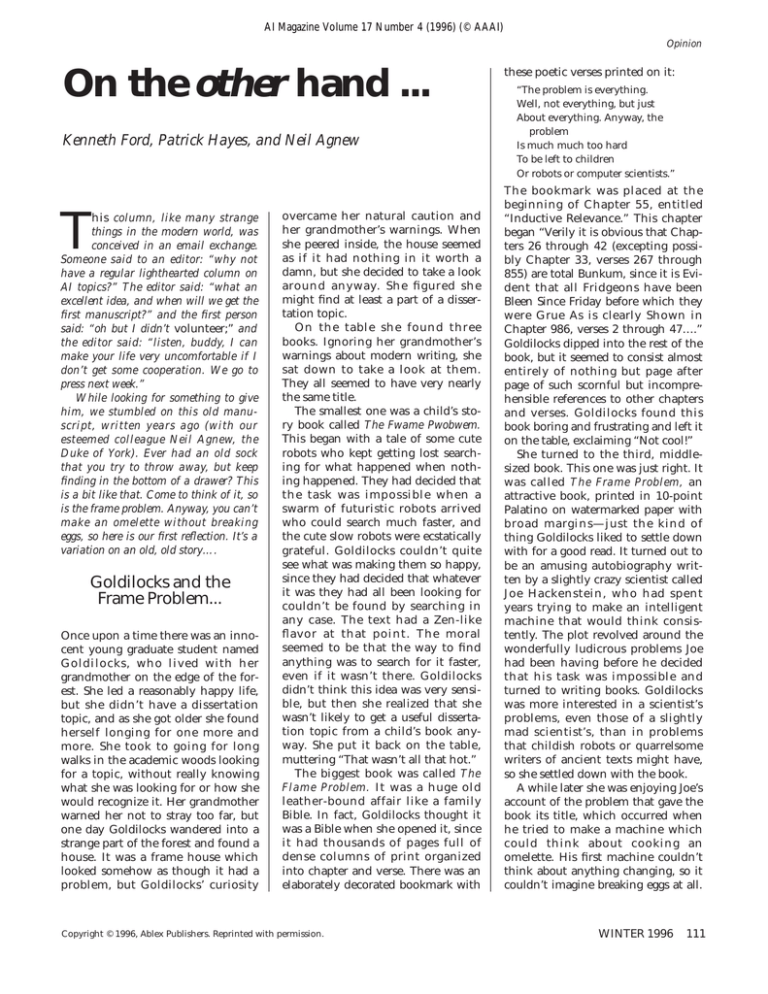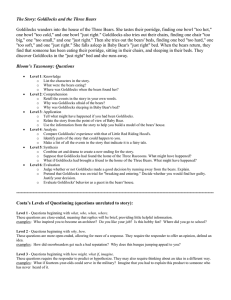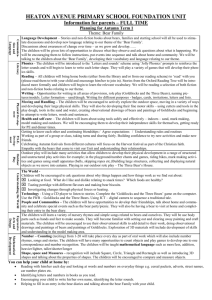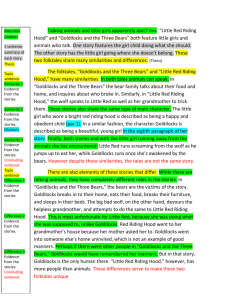T
advertisement

AI Magazine Volume 17 Number 4 (1996) (© AAAI) Opinion On the other hand ... Kenneth Ford, Patrick Hayes, and Neil Agnew T his column, like many strange things in the modern world, was conceived in an email exchange. Someone said to an editor: “why not have a regular lighthearted column on AI topics?” The editor said: “what an excellent idea, and when will we get the first manuscript?” and the first person said: “oh but I didn’t volunteer;” and the editor said: “listen, buddy, I can make your life very uncomfortable if I don’t get some cooperation. We go to press next week.” While looking for something to give him, we stumbled on this old manuscript, written years ago (with our esteemed colleague Neil Agnew, the Duke of York). Ever had an old sock that you try to throw away, but keep finding in the bottom of a drawer? This is a bit like that. Come to think of it, so is the frame problem. Anyway, you can’t make an omelette without breaking eggs, so here is our first reflection. It’s a variation on an old, old story…. Goldilocks and the Frame Problem... Once upon a time there was an innocent young graduate student named Goldilocks, who lived with her grandmother on the edge of the forest. She led a reasonably happy life, but she didn’t have a dissertation topic, and as she got older she found herself longing for one more and more. She took to going for long walks in the academic woods looking for a topic, without really knowing what she was looking for or how she would recognize it. Her grandmother warned her not to stray too far, but one day Goldilocks wandered into a strange part of the forest and found a house. It was a frame house which looked somehow as though it had a problem, but Goldilocks’ curiosity overcame her natural caution and her grandmother’s warnings. When she peered inside, the house seemed as if it had nothing in it worth a damn, but she decided to take a look around anyway. She figured she might find at least a part of a dissertation topic. On the table she found thr ee books. Ignoring her grandmother’s warnings about modern writing, she sat down to take a look at them. They all seemed to have very nearly the same title. The smallest one was a child’s story book called The Fwame Pwobwem. This began with a tale of some cute robots who kept getting lost searching for what happened when nothing happened. They had decided that the task was impossible when a swarm of futuristic robots arrived who could search much faster, and the cute slow robots were ecstatically grateful. Goldilocks couldn’t quite see what was making them so happy, since they had decided that whatever it was they had all been looking for couldn’t be found by searching in any case. The text had a Zen-like flavor at that point. The moral seemed to be that the way to find anything was to search for it faster, even if it wasn’t there. Goldilocks didn’t think this idea was very sensible, but then she realized that she wasn’t likely to get a useful dissertation topic from a child’s book anyway. She put it back on the table, muttering “That wasn’t all that hot.” The biggest book was called The Flame Problem. It was a huge old leather-bound affair like a family Bible. In fact, Goldilocks thought it was a Bible when she opened it, since it had thousands of pages full of dense columns of print organized into chapter and verse. There was an elaborately decorated bookmark with Copyright © 1996, Ablex Publishers. Reprinted with permission. these poetic verses printed on it: “The problem is everything. Well, not everything, but just About everything. Anyway, the problem Is much much too hard To be left to children Or robots or computer scientists.” The bookmark was placed at the beginning of Chapter 55, entitled “Inductive Relevance.” This chapter began “Verily it is obvious that Chapters 26 through 42 (excepting possibly Chapter 33, verses 267 through 855) are total Bunkum, since it is Evident that all Fridgeons have been Bleen Since Friday before which they were Grue As is clearly Shown in Chapter 986, verses 2 through 47….” Goldilocks dipped into the rest of the book, but it seemed to consist almost entirely of nothing but page after page of such scornful but incomprehensible references to other chapters and verses. Goldilocks found this book boring and frustrating and left it on the table, exclaiming “Not cool!” She turned to the third, middlesized book. This one was just right. It was called The Frame Problem, an attractive book, printed in 10-point Palatino on watermarked paper with broad margins—just the kind of thing Goldilocks liked to settle down with for a good read. It turned out to be an amusing autobiography written by a slightly crazy scientist called Joe Hackenstein, who had spent years trying to make an intelligent machine that would think consistently. The plot revolved around the wonderfully ludicrous problems Joe had been having before he decided that his task was impossible and turned to writing books. Goldilocks was more interested in a scientist’s problems, even those of a slightly mad scientist’s, than in problems that childish robots or quarrelsome writers of ancient texts might have, so she settled down with the book. A while later she was enjoying Joe’s account of the problem that gave the book its title, which occurred when he tried to make a machine which could think about cooking an omelette. His first machine couldn’t think about anything changing, so it couldn’t imagine breaking eggs at all. WINTER 1996 111 Opinion New Papers in Planning Advanced Planning Technology: Technological Achievements of the ARPA/Rome Laboratory Planning Initiative Edited by Austin Tate This volume presents the range of technological results that have been achieved with the ARPA/Rome Laboratory Planning Initiative. Five lead articles introduce the program and its structure and explain how the more mature results of individual projects are transferred through technology integration experiments to fielded applications. The main body of this volume comprises one paper from each group or project within ARPI. Each of these papers seek to introduce the technological contribution of the group’s work and provide a pointer to other work of that group. ISBN 0-929280-98-9 282 pp., index, $55.00 softcover Proceedings of the Third International Conference on Artificial Intelligence Planning Systems Edited by Brian Drabble The 1996 proceedings have tried to bring together a diverse group of researchers representing the various aspects and threads of the planning community. As with all previous AIPS conferences, the papers have been selected on technical merit. They include practical algorithms for achieving efficiency in planning, formal results on the completeness and complexity of planning domains, classical planning, formal specification of planning knowledge and domains, constraint-satisfaction techniques and their application, reactive planning, and repair and consistency checking in schedules. ISBN 0-929280-97-0 292 pp., index, $55.00 softcover Available from The AAAI Press • 445 Burgess Drive, Menlo Park, CA 94025 (415) 328-3123 • (415) 321-4457 (fax) • http://www.aaai.org Joe made one which was able to think about eggs breaking, but this one didn’t realize that breaking the egg made the yolk fall into the bowl. Joe went back to his laboratory and rebuilt the machine so that it was able to think about events causing other events. The work took him years and Joe was rather proud of the result. This new version was able to talk, and it could imagine anything causing 112 AI MAGAZINE anything. But when he told the machine to imagine breaking an egg, it asked him if the bowl was still in the same place. “Yes,” he said, “eggbreaking doesn’t cause bowl-moving.” “Ah,” said the machine, “thank you, I will remember that.” Then it asked him if the table was still in the same place. Sensing a problem, Joe said yes, explaining that nothing moved when the egg broke. “Oh,” said the machine brightly, “so the yolk is still in the egg!” “No, no, no!” cried Joe, with despair in his voice, “of course not!” Then the machine asked him what he meant by “of course”; and Joe realized that he had a serious problem. Before Goldilocks had a chance to think very hard about dissertation topics, she was frightened by voices and the sound of feet coming towards the house. She dropped the book and ran into the kitchen to hide. While tasting the bowls of porridge she found there (the one in the middle was definitely better than the other two) she heard bearish voices in the room she had just left. A baby bear’s voice whined, “Someone’s been reading my book!” A mother bear’s voice said with brisk annoyance, “Someone’s been reading my book—and lost my page! I do wish bears would be more considerate with other bears’ things! As if I don’t have enough to do in this house, what with all the frozen salmon and…,” when a deep, powerful bear’s voice boomed angrily, “Someone’s been trying to read my book.” Goldilocks wondered what to do, and thought about looking for a comfortable bed somewhere, but before she could move, the three bears burst into the kitchen. Standing on the other side of the table, they glared at Goldilocks, looked at the bowls, then all shouted furiously, in unison, “Someone’s been eating our breakfasts!” Goldilocks didn’t stay to find out any more: she leaped through the window and ran all the way home as fast as her legs could carry her. (She never again went back into that part of the woods, and she eventually got her Ph.D. in fuzzy control theory.) The bears, however, were still upset by this intrusion into their lives. The baby bear burst into tears, and father bear said sternly, “Come, now, don’t be silly. Your mother will make some more breakfast. Remember the brave words of our ancestors: nothing really changes almost anything!” Baby bear looked puzzled and snuffled “I don’t understand….” Mother bear looked at her husband witheringly and said, “You see? That’s the problem.”





